The document provides an overview of complex and user-defined types in C++, focusing on structures, enumerations, and unions, as well as arrays. It explains how these types can be used to represent real-world data, including examples of their implementation. Additionally, it highlights the differences between built-in and user-defined types, along with some basic operations and considerations when working with arrays.
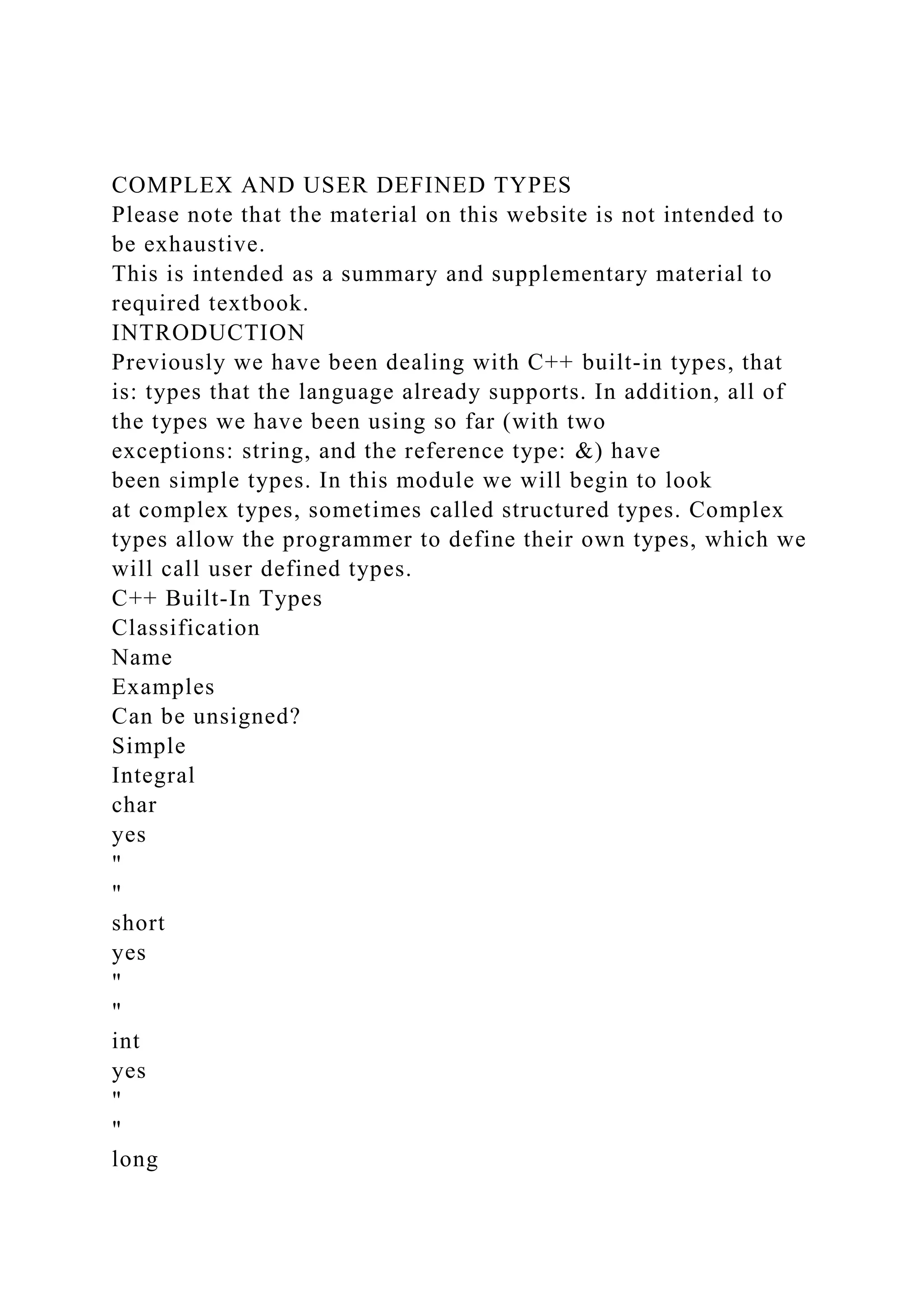
![yes
"
"
bool
no
"
Enumerated
enum
"
"
Decimal
float
"
"
"
double
"
"
"
long double
"
Address
Pointer
* (asterisk)
"
"
Reference
& (ampersand)
"
Complex
Array
[ ] (brackets)
"
"
Structured
struct](https://image.slidesharecdn.com/complexanduserdefinedtypespleasenotethatthematerialont-221108010946-79daa4bf/75/COMPLEX-AND-USER-DEFINED-TYPESPlease-note-that-the-material-on-t-docx-2-2048.jpg)
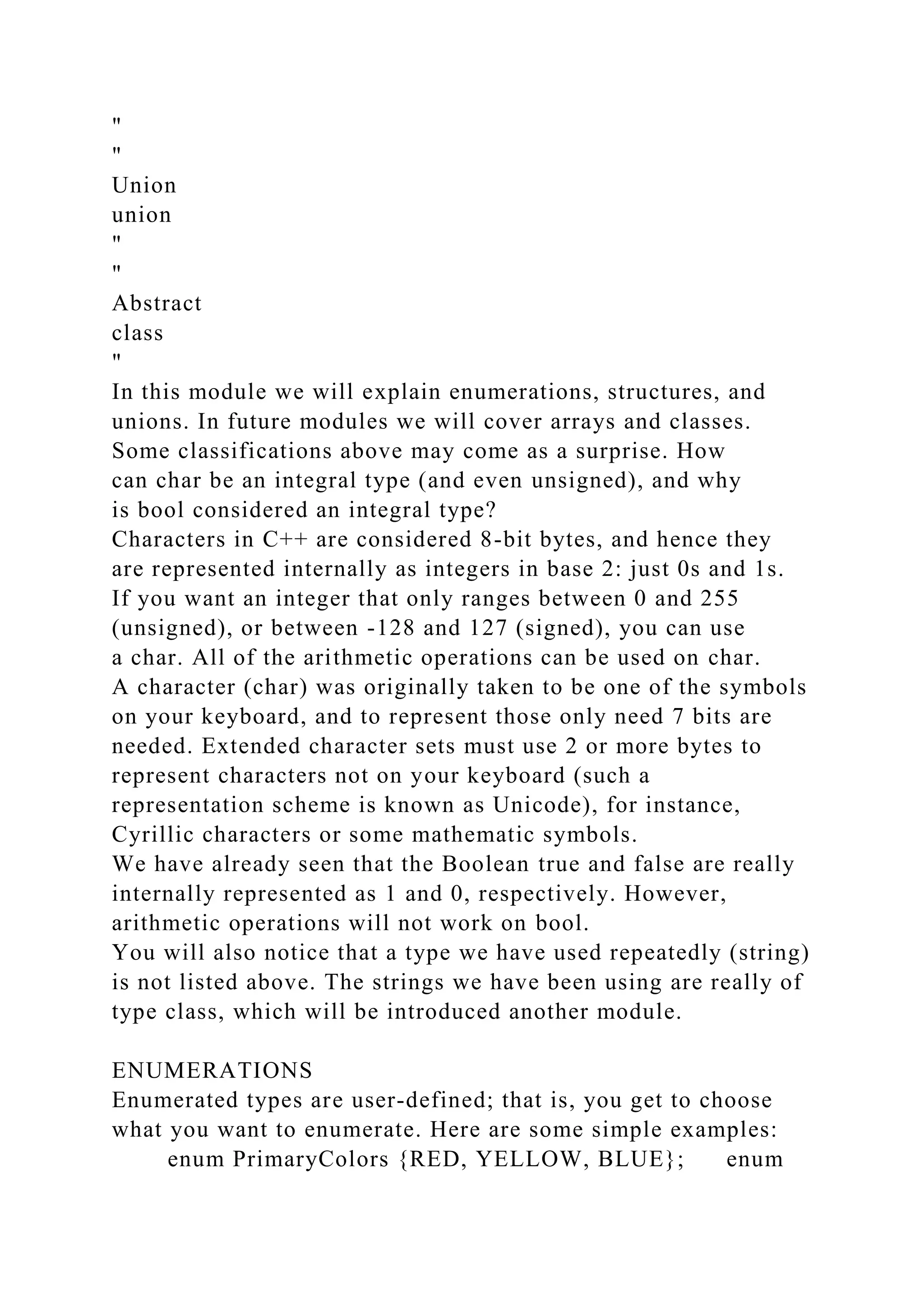
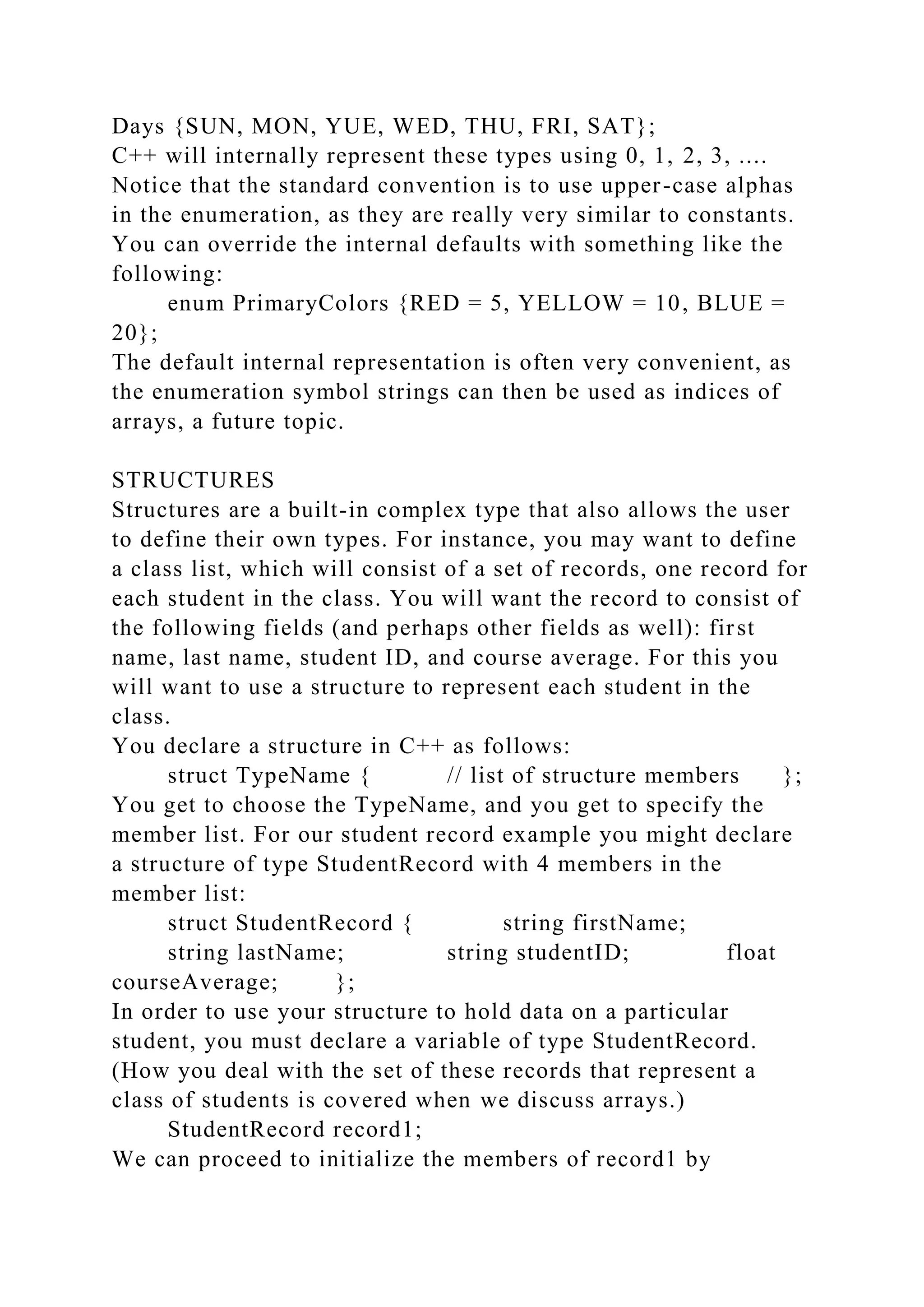
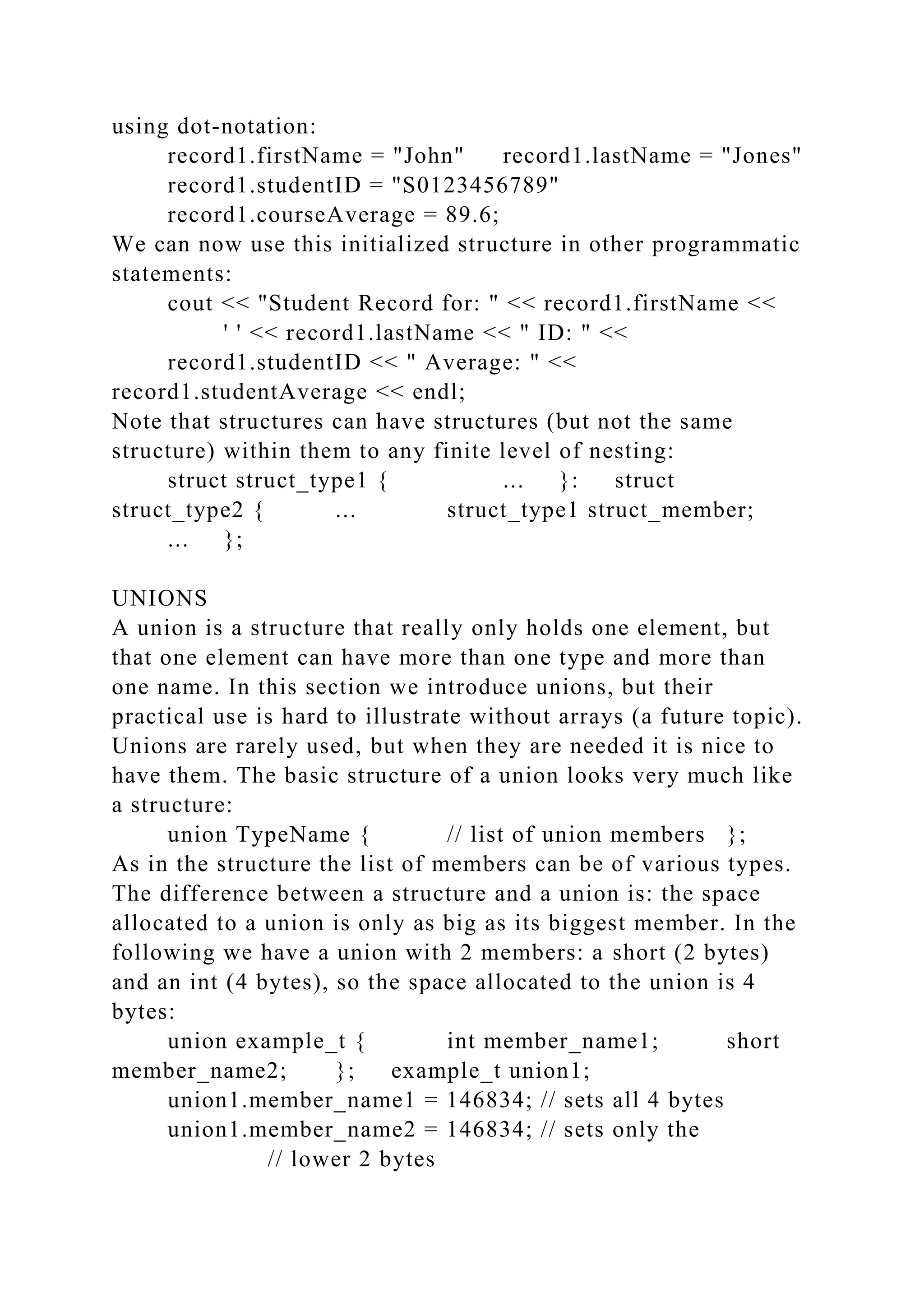
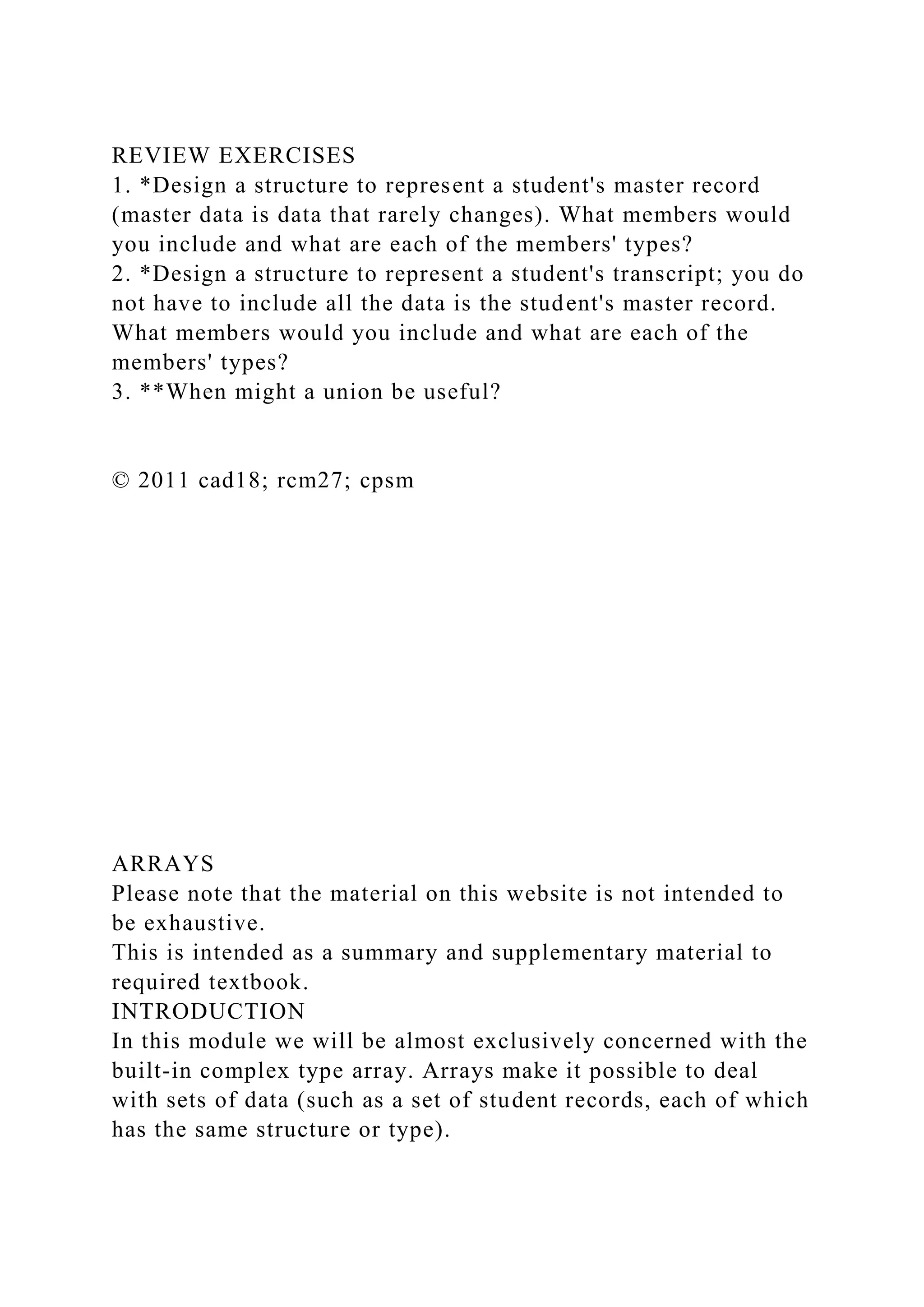
![BASIC DEFINITIONS
An array is a finite set of elements stored in memory in which
the elements are all of the same type. Hence, arrays are distinct
from structures in that structures can contain elements of any
type. The number of elements in an array is called its size.
Arrays can consist of elements of any single type, but we will
begin with character arrays.
Recall that characters typically require one byte of storage per
character, so an array of 8 characters will require 8 bytes; we
declare an array by naming the type, naming the array, and
indicating its size inside the array symbol: [ ].
char myArray [8];
We can also initialize an array in its declaration.
char myArray [] = {'A', 'B', 'C', 'D', 'E', 'F', 'G', 'H'};
Notice that in this case we did not have to indicate the size in
between the brackets, as the size is indicated by the set of
initial values (compilers can count).
Now that we have an array of 8 characters, we access an
individual element by using the index of the individual element.
The index of the first element in the array above ('A') is 0; the
index of the last element ('H') is 7. In general (and this is true
of all languages derived from C) an array with n elements has
indices ranging from 0 to n-1. If you try to reference the nth (or
higher) element you will be referencing a non-array element and
this is an error: out of range; you will commit the same error if
you use a negative index.
Arrays are most often processed by for loops, but usually any
loop will do as well. Here is a code snippet that initializes an
array, sums up the elements of that array, and computes the
average. Note especially that the limit on the for loop uses <,
NOT <=.
const int ARRAYSIZE = 10; ... int numArray
[ARRAYSIZE] = {2, 6, 3, 8, 19, -1, 0, 22, -6, 10}; int i, sum =
0; double average; ... for (i = 0; i < ARRAYSIZE; i++)
{ sum += numArray[i]; } average = (double)sum
/ (double)ARRAYSIZE;](https://image.slidesharecdn.com/complexanduserdefinedtypespleasenotethatthematerialont-221108010946-79daa4bf/75/COMPLEX-AND-USER-DEFINED-TYPESPlease-note-that-the-material-on-t-docx-7-2048.jpg)

![want to pass the 4th element of a 10-element integer array, you
can do so as follows; using numArray declared above:
int myFunction (int); // prototype ... int index = 3; int
ret; ... ret = myFunction (numArray[index]); ...
You can pass in an array element and make it possible for the
called function change the element by passing it by reference:
int myFunction (int&); // prototype ... int index = 3; int
ret; ... ret = myFunction (numArray[index]); ...
The entire array can also be passed into a function, but in this
case you must also pass in the size of the array:
int findLeast (int [], int); // prototype ... int ret; ret
= findLeast (numArray, ARRAYSIZE); ...
However, if you pass the entire array into a function, the
compiler will not put the entire array on the stack (who knows
how many elements that could be). Instead, the compiler will
place a pointer to the array on the stack, that is, the address of
the first element of the array. In effect, this amounts to passing
the entire array by reference and allows the called function to
modify the array. If you do not want to give the called function
the ability to modify the array, you must declare the array
passed as const.
int findLeast (const int [], int); // prototype
ARRAYS OF OTHER TYPES
So far, we have used examples of character and integer arrays,
but any type, whether built-in or user-defined, can be used in
arrays. Always remember that arrays can consist only of objects
of the same type. So, arrays can consist of:
· Characters
· Integers: short, int, long
· Decimals: float, double, long double
· Strings
· Structures and unions: struct and union
· Classes
· Even arrays themselves (arrays of arrays are multi-
dimensional arrays; see below)](https://image.slidesharecdn.com/complexanduserdefinedtypespleasenotethatthematerialont-221108010946-79daa4bf/75/COMPLEX-AND-USER-DEFINED-TYPESPlease-note-that-the-material-on-t-docx-9-2048.jpg)
![STRINGS AND CHARACTER ARRAYS
Recall that C++ makes a distinction between character arrays
and strings: string is actually a class. When we open a file we
can pass as its name a literalstring, such as: "myTextFile.txt".
Or, we can pass a string variable to the open call. But, in order
to do so, we must convert the string to a character array.
string myFile = "myTextFile.txt" ... ifstream inFile
(myFile.c_str(), ios::in); ...
The c_str() string function converts the string myFile into a
traditional C-language character array. In C, character arrays
that represent strings are always terminated by a null byte: '0'
(an ASCII character equal to 0).
Most C++ programmers prefer to use the string class instead of
the traditional C-language character array, as the string
operators, such as ==, !=, and +, are extremely convenient.
TWO-DIMENSIONAL ARRAYS
We mentioned earlier that you can have arrays of arrays. Most
often these are 2-dimensional arrays, which we can think of laid
out in rows and columns, just like a spreadsheet.
We access these arrays by supplying a row index and a column
index. The following is an example of initializing a 2-
dimensional array that has 300 rows and 10 columns: 3000
elements altogether. Note that the row number is always first, as
it is the primary index. The column number is secondary. Row
indices can range from 0 to 299; column indices can range from
0 to 9.
int array2D [300][10]; ... for (int i = 0; i < 300; i++)
for (int j = 0 j < 10; j++) array2D[i][j] = 0;
...
When passing two-dimensional arrays to functions
you should also pass both dimensions:
void myFunction (int [ ], int, int); // prototype ... int
myArray [100] [10]; ... myFunction (myArray, 100, 10);
Two-dimensional arrays will be covered further in the module](https://image.slidesharecdn.com/complexanduserdefinedtypespleasenotethatthematerialont-221108010946-79daa4bf/75/COMPLEX-AND-USER-DEFINED-TYPESPlease-note-that-the-material-on-t-docx-10-2048.jpg)
![on matrices and linear systems.
MULTIDIMENSIONAL ARRAYS
We can, of course also have 3-dimensional, 4- dimensional, ...
arrays, but these are harder to picture, A 3-dimensional array
will have 3 indices. You can think of a 3-dimensional array as a
2-dimensional array in which each cell in that array has many
elements. A visual analogy would be a solid in 3-dimensional
space (mathematical 3-space does NOT have a finite number of
points, whereas arrays in C++ are necessarily finite).
int array3D [2][3][4]; // prototype ... array3D[0][2][1]
= 0; ...
Of course, 4-dimensional arrays are even harder to imagine, but
an analogy can be made to the 4-dimensional space-time.
REVIEW EXERCISES
1. *The following is a diagram of the memory used by an array
of 8 8-bit (1-byte) characters. Do a similar diagram for an array
of 8 32-bit integers and 8 64-bit doubles.
Byte (Character)
1
2
3
4
5
6
7
8
Index
0
1
2
3
4
5
6](https://image.slidesharecdn.com/complexanduserdefinedtypespleasenotethatthematerialont-221108010946-79daa4bf/75/COMPLEX-AND-USER-DEFINED-TYPESPlease-note-that-the-material-on-t-docx-11-2048.jpg)
![7
Address
n
n+1
n+2
n+3
n+4
n+5
n+6
n+7
2. *What is wrong with the following code snippet?
int myArray [8]; for (int i = 0; i <= 8; i++)
myArray [i] = 0;
3. *What is the dimension of the following array, and what is its
size? Assuming a double is an 8-byte quantity, how many bytes
of memory will the array occupy?
double dArray [2][5][3][4];
4. **C++ has no built-in facility for displaying numbers in
binary. The number 45 base 10 is 00101101 base 2. How can
you display a int (4 bytes max) in binary using cout? Group the
output into 8 blocks of 4 binary digits; that is, 45 should appear
as:
0000 0000 0000 0000 0000 0000 0010 1101
5. **Write a program that initializes an array with the first 30
numbers in the Fibonacci series and then prints out the contents
of the array. The Fibonacci series is generated by the following
rules: both the first and second numbers are 1, every number
after that is the sum of the previous two numbers in the series.
6. ***Bubble Sort. A bubble sort is a sorting of a list of
numbers. The sort can be in either ascending or descending
order. The bubble sort algorithm makes multiple passes through
the list and on each pass examines each adjacent pair of
members on the list and interchanges then if they are not in the
right order. The bubble sort terminates when a pass is made that
requires no interchanges. Beginning with the list: 9, 8, 7, 6, 5,](https://image.slidesharecdn.com/complexanduserdefinedtypespleasenotethatthematerialont-221108010946-79daa4bf/75/COMPLEX-AND-USER-DEFINED-TYPESPlease-note-that-the-material-on-t-docx-12-2048.jpg)
